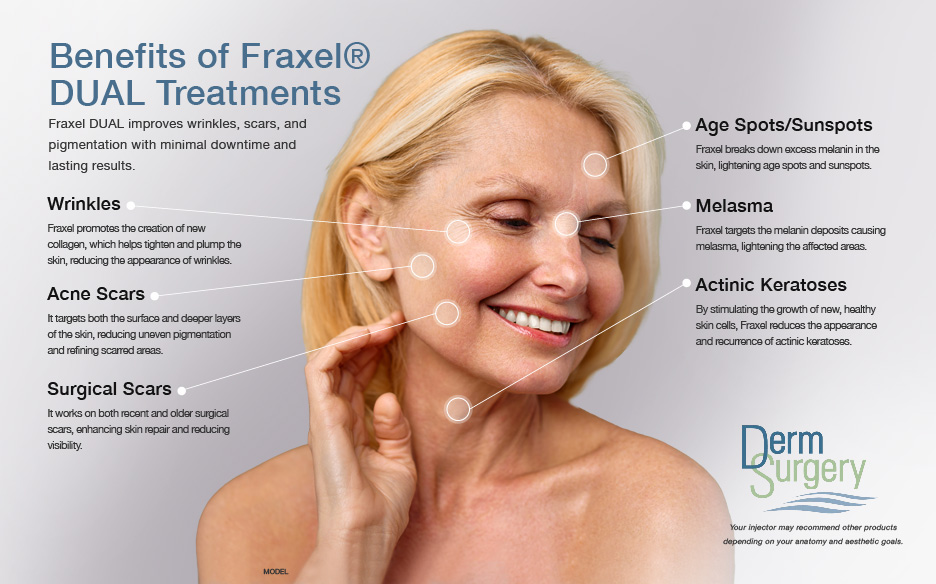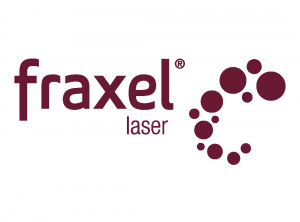DermSurgery Associates
6700 W. Loop South, Suite 500
Bellaire, TX 77401
Phone: (713) 791-9966
Monday–Friday: 8 a.m.–5 p.m.
Friday: 8 a.m.–4 p.m.
Fraxel®
Fraxel treatments at our offices throughout Greater Houston, TX, help women and men from Kingwood, Willowbrook, Pearland, The Woodlands, El Campo, and other nearby areas rejuvenate, refresh, and repair aged or damaged skin. By removing damaged cells and stimulating the production of collagen, both the ablative and non-ablative approaches promote healing and the generation of new, healthier tissues.
Our experienced team of board-certified dermatologists will help you determine the best possible approach for your goals. Thanks to their years of experience with laser treatments, you can rest assured your Fraxel experience will be a safe and rewarding one.
View Before & After Photos
Fraxel DUAL
Fraxel DUAL 1550/1927 laser treatment is the premier Fraxel system for non-ablative skin resurfacing and rejuvenation, delivering remarkable results with minimal downtime. The laser’s 1550 nm and 1927 nm wavelengths, combined with proprietary advancements in optical technology, enable patients to uncover the skin of their youth with minimal disruption to their daily routine.
How Does a Fraxel DUAL Treatment Work?
The Fraxel DUAL laser treatment targets aging and sun-damaged skin with microscopic laser columns that penetrate deep into your skin to expedite your body’s remodeling of collagen. Because the laser treats only a fraction of tissue at a time, it leaves the surrounding tissue intact, which promotes rapid healing. Fraxel DUAL resurfaces your skin by stimulating the growth of new, healthy skin cells from the inside out.
What Conditions Can Fraxel DUAL Treat?
In addition to laser skin resurfacing, Fraxel DUAL can be used to treat:
- Wrinkles around the eyes (periorbital wrinkles)
- Acne scars
- Surgical scars
- Age spots/sunspots (pigmented lesions)
- Melasma (irregular patches of brown skin on the forehead, cheeks, upper lip, and nose)
- Actinic keratoses (precancerous lesions)
What Are the Benefits of Fraxel DUAL Treatments?
- Smoother, fresher, younger-looking skin
- Improved tone and texture
- Removal of unwanted brown spots
- Reduced fine lines and wrinkles around the eyes
- Improved appearance of acne scars and surgical scars

How Are Fraxel DUAL Treatments Performed?
First, your skin will be cleansed. Then, about 60 minutes prior to treatment, a topical anesthetic ointment will be applied to the treatment area. During treatment, the handpiece is passed over the skin to deliver the laser’s energy into the skin. The Fraxel DUAL procedure takes 20 to 25 minutes for a full face.
Do Fraxel DUAL Treatments Hurt?
Most people describe an increased sensation of heat during the treatment. To minimize discomfort, topical anesthetic is applied before the procedure and cold air is used on the treatment area during the procedure.
What Should I Expect After a Fraxel DUAL Treatment?
During the first 24 hours after treatment, your skin may feel as though it is sunburned, and it will appear pink or red. You can wear makeup to reduce the sunburned appearance. Your skin will naturally bronze over the next week or two, and as you continue treatment, the sunburned-to-bronzed appearance will repeat. As with a sunburn, your skin will flake and exfoliate normally. Use a moisturizer to reduce the appearance of dry flakes.
What Side Effects Can I Expect After a Fraxel DUAL Treatment and How Long Will They Last?
Swelling and redness are the most common side effects of a Fraxel DUAL treatment. Any swelling is typically minimal and subsides within a day or two, and any redness typically fades within a few days. Other temporary side effects may include minor itching, dry skin, peeling or flaking, and a bronzed skin appearance. There is a limited risk of infection, hyperpigmentation, or scarring. The intensity and duration of side effects depend on the aggressiveness of a treatment and on your particular healing characteristics. We will provide specific instructions about what to expect and how to minimize any side effects.
What Precautions Should I Take After a Fraxel DUAL Treatment?
Wear sunscreen of SPF 30 or higher, avoid direct sun exposure for at least 3 months after your last treatment, and wear a wide-brimmed hat when you’re in the sun.
How Many Fraxel DUAL Treatments Will I Need and How Will They Be Spaced?
Clinical studies suggest that on average, an effective treatment regimen is 3 to 5 sessions spaced about 2 to 4 weeks apart. Depending on your condition and schedule, we may choose to space treatment sessions further apart. Results are immediate and progressive, with optimal improvement usually visible in 2 to 3 months. This time frame and treatment structure allow for complete healing and the production of new collagen and elastin to replace damaged tissue.
How Long Do the Positive Effects of Fraxel DUAL Treatments Last?
It depends on your particular condition and how you care for your skin. Once your skin is treated, continue to protect it as described above. We will give you specific advice based on your individual needs.
Fraxel re:pair
The Fraxel re:pair laser combines all the benefits of traditional ablative resurfacing lasers without the prolonged downtime and significant risk of side effects. With Fraxel re:pair, the skin heals vertically instead of horizontally as with traditional bulk ablation. In addition, clinical data suggests that Fraxel re:pair, unlike conventional CO2 lasers, is safe for off-the-face treatments.
How Is a Fraxel re:pair Treatment Different From a Fraxel DUAL Treatment?
Both Fraxel re:pair and Fraxel DUAL use fractional technology, but in different ways. As an ablative procedure, Fraxel re:pair uses a carbon dioxide (CO2) laser to vaporize microscopic columns of tissue deep within the skin. Fraxel re:pair is a more aggressive procedure and is used to treat the most severe signs of skin damage. Results are achieved in 1 or 2 treatments and wound care recovery time (usually 24 to 72 hours) is generally longer than other Fraxel treatments. Fraxel DUAL, on the other hand, is a non-ablative technique that intensively treats older skin cells while leaving the skin’s protective barrier intact. This results in less downtime and need for post-treatment wound care.
What Are the Benefits of Fraxel re:pair Treatments?
- Significant results in a single treatment
- Smoother, more even skin tone and texture
- Softening of deep frown lines and wrinkles
- Improved appearance of redness caused by sun damage
How Are Fraxel re:pair Treatments Performed?
First, your skin will be cleansed. Then, 60 to 90 minutes prior to treatment, a topical numbing agent will be applied to the treatment area. Your physician may also choose to give you another medication, such as Ativan, to relax you. During treatment, the handpiece is passed over the treatment area to deliver the laser’s energy into the skin. The procedure takes approximately 20 to 30 minutes for a full face.
Does Fraxel re:pair Hurt?
Most patients describe an increased sensation of heat during the treatment, and there may be some discomfort. Topical anesthetic and other medications are provided to enhance your comfort. However, unlike the experience in traditional CO2 treatments, you will feel quite comfortable immediately after a Fraxel re:pair treatment.
What Side Effects Should I Expect After a Fraxel re:pair Treatment and What Are The Risks?
Depending on the aggressiveness of your treatment, there might be some pinpoint bleeding following the procedure, as well as some oozing for up to 48 hours until the wounds close. The most common side effects are edema (swelling), which usually subsides after a week, and erythema (redness), which may last up to a month, depending on the aggressiveness of treatment. Other temporary side effects may include minor itching, dry skin, peeling or flaking, oozing, and crusting. As with all ablative laser procedures, there is an elevated risk of delayed wound healing, infection, pigment changes (hyperpigmentation), and scarring.
How Long Do the Positive Effects Of Fraxel re:pair Treatments Last?
The results of Fraxel re:pair treatment are both immediate and progressive. Soon after the treatment, the surface of your skin will feel softer, look brighter, and show more even tone. The next 3 to 6 months will bring more improvement as the deeper layers of the skin continue to heal.
Fraxel FAQs
Is Fraxel or microneedling better?
The choice between Fraxel and microneedling depends on your specific skin concerns and goals. Fraxel is more powerful and penetrates deeper into the skin, making it effective for treating deeper wrinkles, scars, and significant pigmentation issues.
Microneedling is generally milder and primarily targets fine lines, mild scarring, and overall skin texture. The best option for you depends on the severity of your concerns and your tolerance for downtime, as Fraxel may have a longer recovery period.
What’s the best age to start Fraxel?
There is no “best” or “right” age to start Fraxel treatments, as it depends on your individual skin concerns. Patients in their 30s and older often use Fraxel to address signs of aging, sun damage, and skin imperfections. However, younger individuals with specific concerns like acne scars or uneven skin tone may also benefit from this treatment.
Should I get a Fraxel treatment every year after the first round of treatments?
The frequency of Fraxel treatments after the initial round depends on your skin’s condition and your desired results. Some people choose to have annual maintenance sessions to sustain their results, while others may only need periodic “touch-up” treatments. We will provide personalized recommendations based on your skin’s needs.
Will Fraxel make me look younger?
Fraxel can contribute to a more youthful appearance by comprehensively addressing wrinkles, scars, and pigmentation issues as well as improving skin texture. It also stimulates collagen production, which can lead to smoother, firmer skin. However, the extent of the “youthful” effect varies from person to person.
If you would like to learn more about Fraxel treatments, please call one of our specialists at a location near you.
Fraxel® Locations Near You
High-quality skin care is never far away. Call a convenient location near you to request an appointment.

